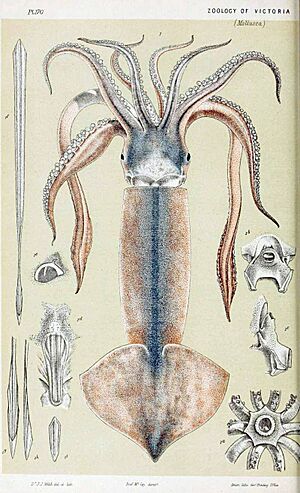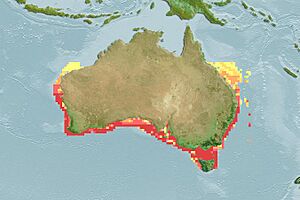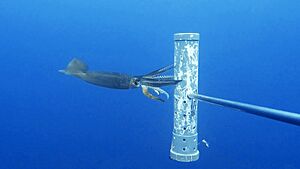Gould's squid facts for kids
Quick facts for kids Gould's squid |
|
|---|---|
 |
|
| Conservation status | |
| Scientific classification | |
| Genus: |
Nototodarus
|
| Species: |
gouldi
|
 |
|
| Map of the approximate distribution of the Gould's Squid | |
The Gould's squid, also called the Gould's flying squid or arrow squid, is a type of squid. Its scientific name is Nototodarus gouldi. This squid lives in the warm and mild waters around Australia and New Zealand. People often catch and eat it. These squids usually live for about one year.
You can typically find the Gould's squid in waters from 50 to 200 meters deep. They live near the coasts and shelves of Australia and New Zealand. Sometimes, they can go much deeper, up to 825 meters. Young squids are sometimes found closer to the shore.
What the Gould's Squid Looks Like
Gould's squids can grow quite large. Their main body, called the mantle, can be up to 40 centimeters long. They can weigh up to 1.6 kilograms, but usually weigh around 0.7 kilograms. Male squids are smaller than females.
They have long feeding tentacles, which can be about 18 centimeters long. This is almost half the length of their body! They also have four pairs of shorter arms near their head. The color of their skin can change. It can be light pink, brown, or even brick red. They also have a dark stripe on the top of their mantle.
Life Cycle and How They Live
Like all squids, the Gould's squid is a hunter. It eats smaller fish, such as barracudas. It also eats other squids. Sometimes, they even eat other Gould's squids! They catch their food with their tentacles. Then, they move the food to their mouth. Under their tentacles, they have a sharp beak to chew and swallow their prey.
Many animals like to eat the Gould's squid. These include birds, large fish, sharks, and marine mammals.
Gould's squids become ready to have babies when they are about 6 months old. When a female squid is ready, she stores a special packet from the male inside her mouth. The eggs get fertilized as they pass through her mouth. Then, she releases them into the water. These eggs are in a jelly-like blob that floats freely. The young squids hatch from this blob about one to two months later. Both the male and female squids die soon after they have laid their eggs. While they can lay eggs at any time of year, most babies are born between February and March.
Fishing for Gould's Squid
People in Australia and New Zealand often catch Gould's squid for food. They usually catch them using a method called jigging. If they are caught by trawling, they are not considered good to eat.
Catching these squids can be tricky. Their numbers in the ocean can change a lot. They also don't stay fresh for very long after being caught. The largest catch ever recorded was 7,914 tons by Japanese fishing boats. Since then, the number of squids caught has generally gone down. In 2017, about 828 tons of squid were caught. We don't know exactly why the numbers have dropped. However, these squids are not considered to be overfished or in danger of disappearing.



